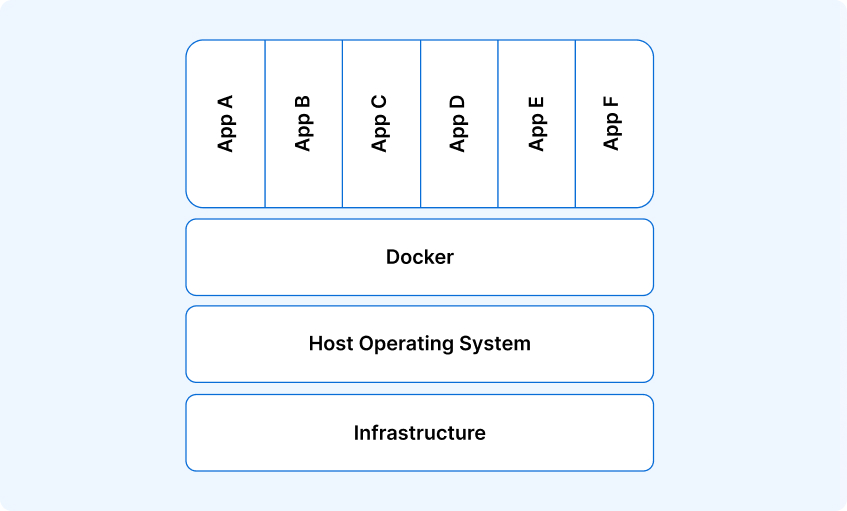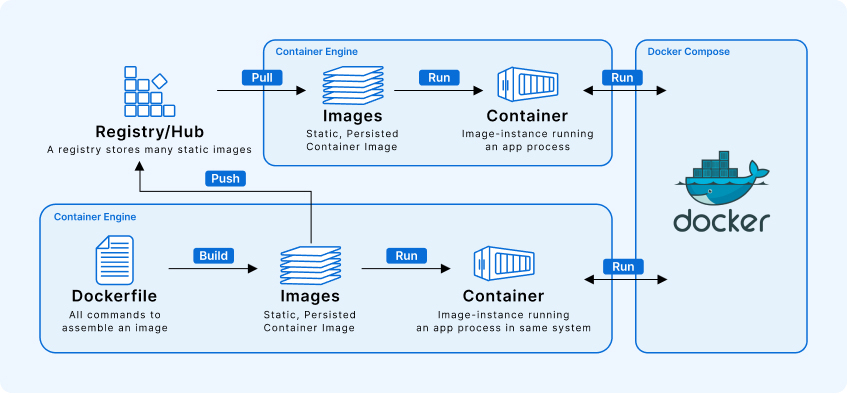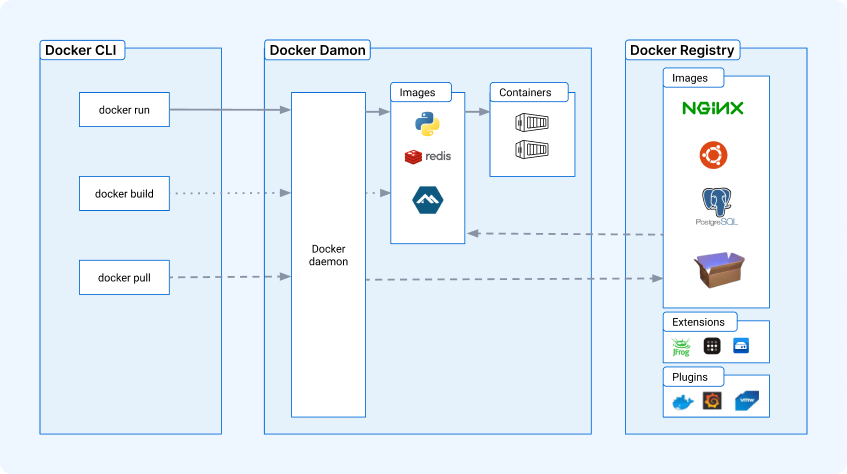The IT industry has rapidly adopted cloud technologies, Microservices, and DevOps practices. The DevOps approach emphasizes creating an end-to-end agile and automated software development and deployment process. Docker has played a vital role in driving DevOps adoption, providing a simple and efficient way to package and deploy software applications. In this blog, we will provide details of containerization and Docker, explain their benefits, and provide practical advice for adopting these technologies.
What is Containerization?
Containerization is a technology that enables developers to package software applications and their dependencies to get into a container, making it easy to deploy and run on any machine or Cloud Hosting platform. Containers are lightweight, executable packages with all the software components needed to run an application. Each container runs in an isolated environment, ensuring the application runs consistently across different domains.

Advantages of Containerization
- Portability: Containers are portable, enabling applications to run consistently across different environments.
- Efficiency: Containers are lightweight and share resources with the host environment, making them efficient.
- Isolation: Containers provide an isolated environment for the application to run, which enhances security and stability.
- Scalability: Containers enable easy scaling of applications horizontally and vertically.
- Speed: Containerization enables faster application deployment.
Disadvantages of Containerization
- Complexity: Containerization can be complex, requiring expertise to set up and manage containers.
- Resource Overhead: Containers have some resource overhead, although less than virtual machines.
- Lack of Visibility: Containers can be challenging to manage and monitor, making troubleshooting complex.
Containerization Architectures

1. Microservices Architecture
Microservices architecture is a critical approach that breaks down an application into smaller, independent services running in its container. This approach enhances the flexibility, scalability, and resilience of applications.
2. Monolithic Architecture
Monolithic architecture packages an entire application and its dependencies into a single container. Monolithic architecture is less complex than microservices but less flexible.
Microservices architecture is a critical approach that breaks down an application into smaller, independent services running in its container. This approach enhances the flexibility, scalability, and resilience of applications.
2. Monolithic Architecture
Monolithic architecture packages an entire application and its dependencies into a single container. Monolithic architecture is less complex than microservices but less flexible.
What is Docker?
Docker is a containerization tool that empowers developers to package, distribute, and run applications in a containerized environment. Docker has quickly become the de facto standard for containerization, thanks to its ease of use, portability, and open-source nature. At its core, Docker provides a simple way to package and distribute container images that can be efficiently run on any Docker-enabled host.
Components of Docker

Docker comprises several vital components, making it a powerful and flexible containerization platform. These include:
- Docker Engine: The Docker Engine is the core component of Docker that runs on the host machine and manages the container lifecycle.
- Docker Image: A Docker Image is a pre-configured, executable package that contains all the software dependencies and configurations required to run an application.
- Docker Registry: Docker Registry is a central repository where Docker images can be stored, versioned, and shared among team members.
- Docker Compose: Docker Compose is a tool for defining and running multi-container applications.
Advantages of Docker
- Portability: Docker containers are portable, making deploying them in different environments easy.
- Efficiency: Docker containers are lightweight and share resources with the host environment, making them efficient.
- Isolation: Docker provides an isolated environment for the application to run, which enhances security and stability.
- Scalability: Docker enables easy scaling of applications horizontally and vertically.
- Speed: Docker enables faster application deployment.
Disadvantages of Docker
- Complexity: Docker can be complex, requiring expertise to set up and manage containers.
- Resource Overhead: Docker containers have some resource overhead, although less than virtual machines.
- Limited Support: Docker may only solve some containerization problems.
Docker architecture

Docker architecture consists of three major components:
- Docker engine: This core Docker technology runs containers, manages containers and container images, and provides APIs to interact with Docker.
- Docker registry: This repository stores Docker images, which can be shared among developers and within an organization.
- Docker CLI: This is the command-line interface developers and system administrators use to interact with Docker.
Docker commands
Docker commands are used to create, manage, and deploy Docker containers. Here are some common Docker commands:
- docker run: This command helps to run a Docker container.
- docker build: This command helps to build Docker images.
- docker pull: This command helps to download a Docker image from a registry.
- docker push: This command helps to upload a Docker image to a registry.
- docker stop: This command helps to stop a running Docker container.
- docker rm: This command helps to remove a Docker container.
How to Get Started with Docker and Containerization
Adopting Docker and containerization may seem daunting, but it can be relatively easy if you follow these steps:
Step 1: Identify the Application Dependencies
Before containerizing an application, you must identify all the software dependencies required to run your application. This includes the software, libraries, and configuration files the application uses.
Step 2: Create a Dockerfile
Once identified the application dependencies, create a Dockerfile. It describes how to build a Docker image. It includes information about the application dependencies, files, and instructions to execute during container creation.
Step 3: Build a Docker Image
Once you have created a Dockerfile, the next step is to build the Docker image. You can make Docker images using the docker build command, which follows the instructions specified in the Dockerfile to create an executable image.
Step 4: Test the Docker Image
After building the Docker image, you should test the application in the container environment to ensure it works correctly.
Step 5: Deploy the Docker Image
Once you test the Docker image, you can deploy it to any Docker-enabled host using the docker run command. You can also use Docker Compose to manage and orchestrate multi-container applications.
Conclusion
Containerization and Docker have become essential tools in the DevOps pipeline, enabling faster application development, testing, and deployment, while reducing the time to configure and deploy applications in different environments. The benefits of containerization and Docker include consistency, portability, efficiency, scalability, reduced time-to-market, and increased agility. However, there are still some disadvantages to containerization and Docker, including complexity and resource overhead.
The choice of containerization architecture and tools depends on the complexity of the application, the level of expertise of the team, and the organization's requirements. Overall, containerization and Docker have revolutionized DevOps, enabling organizations to deliver applications faster and more reliably.
The choice of containerization architecture and tools depends on the complexity of the application, the level of expertise of the team, and the organization's requirements. Overall, containerization and Docker have revolutionized DevOps, enabling organizations to deliver applications faster and more reliably.

Written by / Author
Manasi Maheshwari
Found this useful? Share With
Top blogs
Most Read Blogs
Wits Innovation Lab is where creativity and innovation flourish. We provide the tools you need to come up with innovative solutions for today's businesses, big or small.
© 2026 Wits Innovation Lab, All rights reserved
Crafted in-house by WIL’s talented minds

